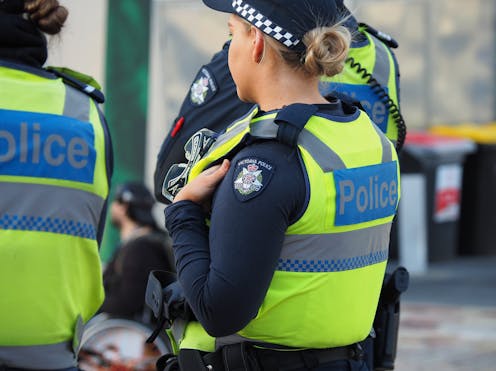
It’s relatively common for perpetrators of family violence to threaten suicide to control a victim-survivor’s actions. A study by the Australian Institute of Criminology suggests 39% of women who experience coercive control are subject to perpetrators’ threats of self-harm.
Suicide threats can be related to mental health issues, a tactic of family violence, or sometimes both. As a result, victim-survivors may feel pressured to remain in an abusive relationship.
Men who kill their partners are 2,000 times more likely to experience suicidal ideation than the general population. For example, the man who killed Hannah Clarke and her children had threatened suicide multiple times in the lead-up to their murders.
It can then be tricky for police responding to these situations. Victoria Police officers who participated in my recently published research were concerned that when they prioritise suicide prevention over responding to family violence, victim-survivors are sometimes left without protection.
Read more: Perpetrators of family violence sometimes use threats of suicide to control their partner
What’s standard police protocol?
The intersection between mental health and family violence is a challenging area for both the legal and health systems, with a variety of laws surrounding both. These laws also differ between states and territories.
In Victoria, police have two main avenues to respond to perpetrator suicide threats: mental health legislation and family violence legislation.
Under mental health laws, police can put someone under the care of a hospital or health practitioners to prevent them harming themselves or others.
Meanwhile, suicide threats can be a form of family violence and coercive control. Police can issue a family violence safety notice to the perpetrator. A notice sets conditions to prevent family violence and protect the victim-survivor. For example, standard conditions of a safety notice include not to commit family violence towards a victim-survivor, or expose a child to family violence. If any conditions are broken, police can charge the perpetrator with a criminal offence with a maximum penalty of two years in prison.
Depending on how receptive a perpetrator is to a safety notice, it may stop them committing further abuse towards the victim-survivor, as well as promote accountability.
In Victoria, there are no formal processes that tell police how to address family violence incidents where the perpetrator has threatened suicide. Police are therefore required to decide how to address the matter based on their experience and knowledge.
In Australia, Queensland is the only state that has publicly available guidance on police addressing perpetrator suicide threats. This framework focuses on managing immediate risk and referral pathways.
Unintended consequences
All ten police officers who participated in my study specialised in family violence. They all indicated suicide threats were a commonly-used tactic of coercive control.
Most participants said when they attend a family violence incident where a perpetrator has threatened suicide, they are likely to address the perpetrator’s mental health as their priority. The perpetrator often then goes to hospital for assessment and treatment, when required.
When a person is under the care of a hospital, police cannot issue a family violence safety notice. Police can request notification from a hospital of when a person is released if they are a risk to others. However, this does not always happen, according to police.

As a result, the perpetrator may be released from hospital without a safety notice in place. Therefore, they may commit some forms of family violence towards a victim-survivor without consequence, if their actions are not criminalised by other law.
The victim-survivor may then be at increased risk of family violence and the perpetrator could avoid accountability. Several officers indicated there have been instances in which perpetrators have been released into the community without an order in place, making this a real risk to victim-survivors.
Learning to balance the risks
Some police stations are developing processes to change the way they address perpetrator suicide threats. One of the participants suggested family violence safety notices should be issued first, before hospitalising a perpetrator.
Improvements within policing could prevent further violence from occurring. A nuanced approach is needed to train police to balance the mental health needs of perpetrators, as well as the safety of victim-survivors and the community at large.
However, the gap in service provision cannot be addressed by police alone.
There is limited information exchange between hospitals and police in some circumstances. We need further communication and collaboration to ensure police can issue safety notices when needed.
Regardless of whether a suicide threat is because of mental health issues, they can be weaponised by perpetrators of family violence. Change is needed to ensure victim-survivors are protected and perpetrators are held accountable.
It is important we continue to research and learn about how family violence and mental health interact, for both perpetrators and victim-survivors. As a result, we can more effectively move towards ending family violence.
Jessica Woolley does not work for, consult, own shares in or receive funding from any company or organisation that would benefit from this article, and has disclosed no relevant affiliations beyond their academic appointment.
This article was originally published on The Conversation. Read the original article.







